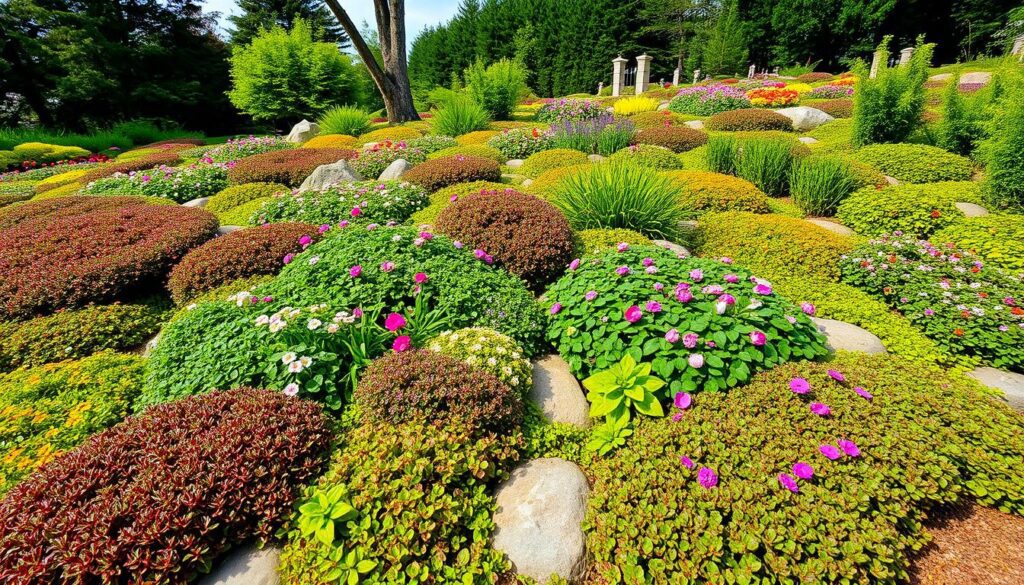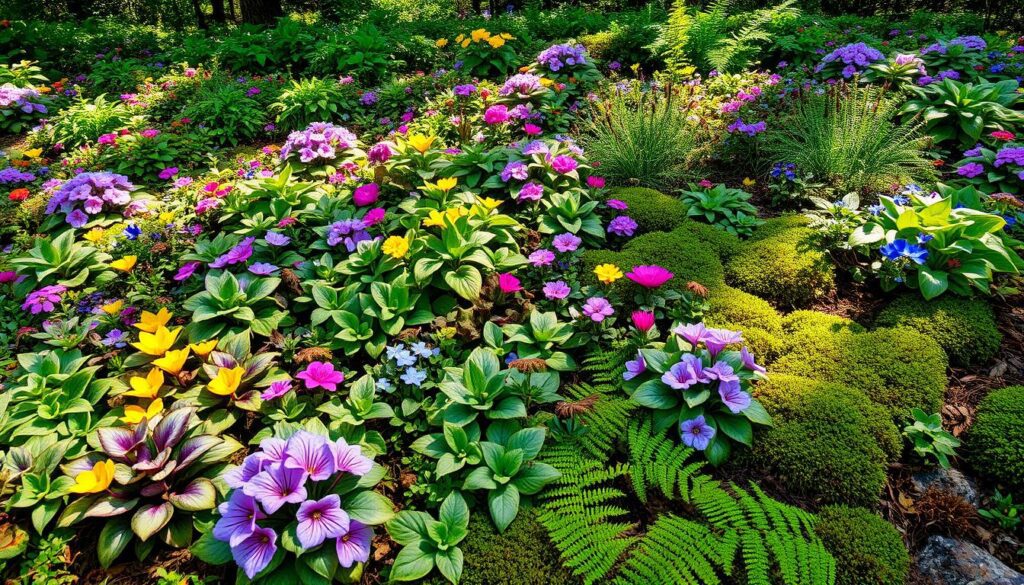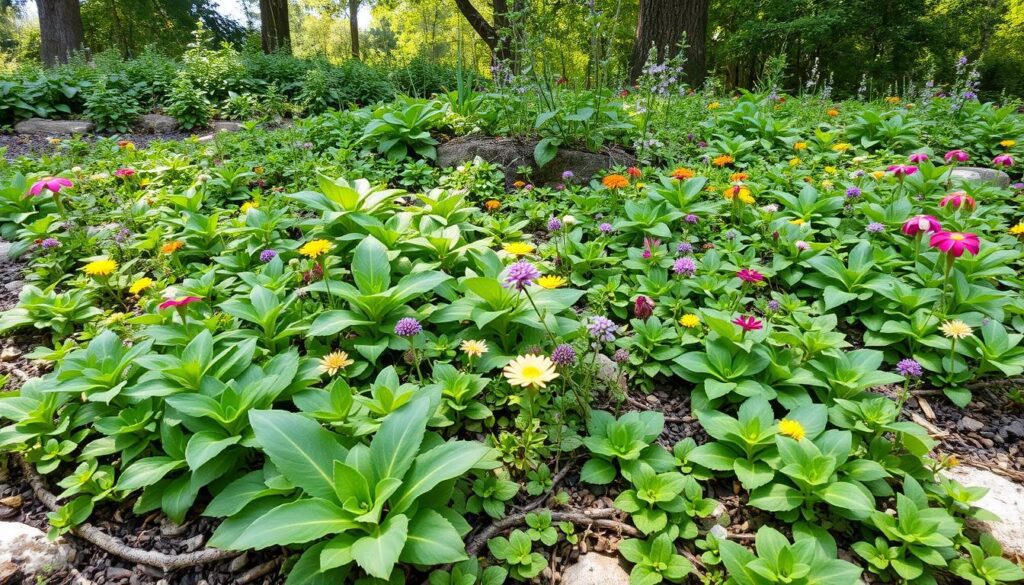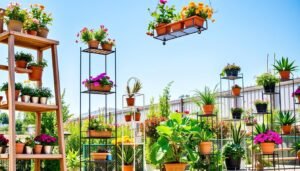Ground cover plants are a great choice for any garden. They offer both practical benefits and beauty. These plants fill in empty spaces, making your garden look lush and full. They also help keep weeds away.
Looking for a garden that’s easy to care for? Or want to make your outdoor space more beautiful? The best ground cover plants can help. They come in many types, suitable for different climates. This guide will help you find the perfect plants for your garden.
Table of Contents
Introduction to Ground Cover Plants
Ground cover plants are great for solving many gardening problems. They are low-growing and spread out, making your property look better. They also do well in shady spots, on slopes, and in poor soil.
These plants need little care, which saves money over time. They can replace grass, cutting down on costs for watering, feeding, and mowing. For example, creeping myrtle and lamb’s ear are good choices for many gardens.
Ground covers are perfect for fighting weeds, covering busy areas, and protecting slopes or dry spots. Remember, they are not the same as cover crops. Cover crops are annuals for soil health, while ground covers are long-lasting, ornamental plants.
When picking ground covers, think about the light and where you live. Junipers are great on slopes for their year-round color. Ajuga is best for shady spots, with its shiny purple leaves that keep weeds away. Creeping thyme is also good for busy areas, staying colorful even when walked on.
In short, ground cover plants are a smart choice for improving your garden. They offer both beauty and practical benefits, making your garden better in many ways.
Benefits of Using Ground Cover Plants
Ground cover plants offer many landscaping benefits for your garden. They stay below three feet, making them perfect for various landscaping needs. One big plus is they help fight weeds by covering the soil.
This makes it hard for weeds to grow. So, you need less weed killer, which is better for the environment.
Ground covers also have environmental benefits. They stop soil from washing away, especially on slopes. Their spreading nature holds the soil in place, preventing erosion.
They soak up extra water, helping control floods. This keeps your landscape safe from water damage.
These plants are easy to care for, great for people with little time. They add color to rock gardens and cut down lawn care time. They also keep the soil moist and the temperature right, helping other plants grow well.
Using different ground cover plants can attract wildlife and keep your garden interesting all year. Each type has its own strengths, making your garden more beautiful and good for the environment. Explore the many options to see how ground cover plants can make your garden a beautiful, easy-to-care-for space.

Best Ground Cover Plants for Shade
When you’re planning your garden in shaded spots, knowing about shade-tolerant plants is key. These ground covers not only do well in little light but also help make your garden look better and stay healthy. They can even compete with tree roots for water and nutrients, keeping your garden lush all year.
Choosing the right plants means you’ll have a garden that’s easy to care for. It will look great and need little upkeep.
Characteristics of Shade-Tolerant Ground Covers
Shade-tolerant plants have special traits that let them grow well in low light. Some important features include:
- Resilience: They can handle little sunlight and poor soil.
- Low Growth Habit: They grow between 3 inches and 3 feet tall, perfect for covering the ground.
- Root Competition: They can get moisture and nutrients from other plants.
- Visual Appeal: They have lush leaves and sometimes flowers to brighten up shady spots.
Top Choices for Shady Areas
Here are some great ground covers for shady spots:
| Plant Name | USDA Hardiness Zone | Height | Features |
|---|---|---|---|
| Creeping Jenny (Lysimachia nummularia) | Zones 3-9 | Up to 12 inches | Golden foliage with yellow flowers; great for low light. |
| Pachysandra (Pachysandra terminalis) | Zones 4-8 | 12 to 24 inches | Evergreen; perfect for dense shade; easy to care for. |
| Bunchberry (Cornus canadensis) | Zones 2-7 | Up to 12 inches | Exquisite white flowers; does well in dense shade. |
| Dwarf Solomon’s Seal (Polygonatum humile) | Zones 5-8 | Up to 18 inches | Elegant stems with white flowers; spreads well. |
| Lilyturf (Liriope muscari) | Zones 6-10 | 12 to 24 inches | Grass-like foliage with blue flowers; drought resistant. |
| Goldenstar (Chrysogonum virginianum) | Zones 5-8 | Up to 12 inches | Brilliant yellow flowers in spring; great for ground cover. |
| Wild Cranesbill (Geranium maculatum) | Zones 4-8 | Up to 18 inches | Beautiful lavender flowers; thrives in shade. |
| Mother of Thousands (Saxifraga stolonifera) | Zones 6-9 | 12 to 24 inches | Unique leaves; good for low light. |
| Vancouveria spp. | Zones 5-9 | Up to 18 inches | Gorgeous foliage; thrives in forest-like settings. |
| Yellow Archangel (Lamium galeobdolon ‘Hermann’s Pride’) | Zones 4-8 | 12 to 24 inches | Silver variegated leaves with yellow flowers; spreads easily. |
Drought Tolerant Ground Cover Plants
Drought tolerant ground cover plants are key for sustainable landscapes. They need little water and look great. These plants survive long without water, thanks to strong roots and leaves that hold moisture.
Choosing these plants helps save water and keeps your outdoor spaces beautiful.
Defining Drought Tolerance
Drought tolerance means a plant can handle dry conditions well. It has special traits like deep roots and small leaves. Using these plants in your garden saves water and is good for the environment.
Recommended Drought Resilient Options
There are many great drought tolerant ground cover plants. Here are some top picks:
| Plant Name | Hardiness Zones | Sun Exposure | Mature Size |
|---|---|---|---|
| Angelina Sedum (Sedum rupestre ‘Angelina’) | 5-9 | Full sun to partial shade | 4-6 inches tall; 1-3 feet wide |
| Bearberry Cotoneaster (Cotoneaster dammeri) | 5-8 | Full sun to partial shade | 1-2 feet tall; 4-6 feet wide |
| California Fuchsia (Epilobium canum) | 8-11 | Full sun | 4-18 inches tall; 2-3 feet wide |
| Creeping Thyme (Thymus praecox) | 5-8 | Full sun | 3-6 inches tall; 6-18 inches wide |
| Dwarf Periwinkle (Vinca minor) | 4-9 | Full sun to dense shade | 3-6 inches tall; 6-18 inches wide |
| Hardy Ice Plant (Delosperma cooperi) | 6-10 | Full sun | 3-6 inches tall; 1-2 feet wide |
| Moss Phlox (Phlox subulata) | 3-9 | Full sun | 4-6 inches tall; 1-2 feet wide |

Adding these plants to your garden makes it more resilient. It stays healthy and looks great even when it’s dry. These varieties are perfect for a garden that’s easy to care for and looks beautiful.
Colorful Ground Cover Plants
Adding colorful ground cover plants to your garden makes it stunning. These plants are not just pretty; they also do well all year. They attract pollinators and add excitement to your garden.
Enhancing Aesthetics with Colorful Options
Colorful ground cover plants can turn a simple garden into a vibrant display. Mixing different plants brings a variety of vibrant garden colors to your space. This creates a lively and inviting atmosphere.
Popular Colorful Ground Covers for Gardens
Many colorful ground cover plants are great for gardens. They come in different types, each with its own special features. Here are a few that do well in different hardiness zones:
| Plant Name | Common Name | Zones | Features |
|---|---|---|---|
| Golden Creeping Jenny | Lysimachia nummularia ‘Aurea’ | 3 to 8 | Bright yellow foliage |
| Double Bird’s Foot Trefoil | Lotus corniculatus ‘Plenus’ | 4 to 10 | Clumping habit with yellow blooms |
| Scotch Moss | Sagina subulata ‘Aurea’ | 4 to 9 | Dense, golden green mat |
| Red Creeping Thyme | Thymus praecox ‘Coccineus’ | 4 to 10 | Bright red flowers in summer |
| Snow in Summer | Cerastium tomentosum | 3 to 9 | White flowers, silvery foliage |

Planting these colorful plants not only makes your garden look good. It also helps create a healthier environment. Choosing plants like Purple New Zealand Burr and Labrador Violet adds unique colors and textures. Each choice makes your garden more beautiful and enjoyable.
- Transform Your Backyard Into an Italian Garden Paradise
- Garden Pond Backsplash Ideas: Transform Your Water Feature
- Front Yard Succulent Garden Ideas: Create a Desert Oasis
- Create Your Perfect Indoor Herb Garden Planters
- DIY Herb Garden From Pallets: Easy Growing Guide
Native Ground Cover Plants for Ecological Benefits
Using native ground cover plants in your garden helps the environment. These plants grow well in their natural habitats. They need less water and care, which means fewer chemicals are used.
Traditional ground covers like English ivy and periwinkle can harm local ecosystems. They can crowd out native plants. This is bad for the environment.
- Native plants like wild ginger and white wood aster are better for local wildlife.
- Ground covers like Virginia creeper and dwarf cinquefoil are good for both looks and wildlife.
- Choosing native plants makes your garden look better and need less care.
When picking plants, think about the light and soil they need. For example, plants that like shade work well in big, easy-to-care-for gardens.

Here’s a quick guide to native ground covers based on light and soil needs:
| Light Conditions | Soil Type | Recommended Native Ground Covers |
|---|---|---|
| Part to Full Shade | Moderately Fertile | Hay-scented fern, green-and-gold |
| Full Sun | Dry Sandy or Gravelly | Golden ragwort, wild strawberry |
| Full to Part Sun | Medium Moisture | Wild ginger, Virginia creeper |
| Part Shade | Acidic Soils | Dwarf cinquefoil, white wood aster |
Choosing native plants makes your garden look great and helps the environment. This choice is key to keeping local wildlife and ecosystems healthy.
Evergreen Ground Cover Plants
Evergreen ground cover plants are great for gardens because they stay green all year. They are especially useful in winter when other plants fade. These plants are easy to care for, making your garden look good all the time.
Advantages of Evergreen Ground Covers
Evergreen ground covers are not just pretty. They also help keep weeds away and prevent soil erosion. They keep the soil moist and can grow in many places. Here are some benefits:
- Consistent foliage: Remains green even in winter.
- Low maintenance: Minimal care required once established.
- Soil preservation: Erosion control and improvement of soil structure.
Top Picks for Year-Round Foliage
Here are some top picks for evergreen ground covers that do well in different places:
| Plant Name | Growth Habit | Hardiness Zones |
|---|---|---|
| Creeping Juniper | Spreads 6-8 feet; grows up to 2 feet tall | 3-9 |
| Creeping Myrtle (Vinca minor) | Fast growth, suppresses weeds | 4-9 |
| Pachysandra (Japanese Spurge) | Grows 10-12 inches, takes 1-2 years to establish | 4-9 |
| Creeping Thyme | Low-growing mat, hardy and drought-resistant | 4-9 |
| Creeping Rosemary | Spreads up to 3 feet; ideal for warmer areas | 8-11 |
Adding these evergreen plants to your garden makes it lively all year. They come in different textures and colors. This makes your garden look amazing and is easy to take care of. Evergreen ground covers make gardening simple and beautiful.
Low Growing Ground Covers for Compact Spaces
In small space gardening, low-growing ground covers are essential. They fill gaps and add beauty. These plants stay close to the ground, perfect for small gardens. They are easy to care for and popular among gardeners.
Why Low-Growing Cover is Ideal
Low-growing ground covers are great for small areas. They create lush carpets without taking over. They also suppress weeds, add texture, and bloom in colors, enhancing your garden’s look.
There are many species to choose from, fitting your garden’s needs and your style. Many thrive in USDA Zones 3-10, covering a wide climate range.
Best Options for Small Gardens
The following table showcases some excellent low-growing ground cover options suited for compact gardening:
| Plant Name | Zones | Sun Exposure | Height | Spread | Soil Preference |
|---|---|---|---|---|---|
| Creeping Thyme | 3-9 | Full sun | 3-6 inches | Up to 2 feet | Well-drained, low-fertility |
| Angelina Sedum | 3-10 | Full sun to part shade | 6-10 inches | Up to 2 feet | Well-drained, tolerant of poor soil |
| Creeping Phlox | 3-9 | Full sun | 4-6 inches | Up to 2 feet | Well-drained, alkaline or acid |
| Basket-of-Gold | 4-7 | Full sun | 6-12 inches | Up to 2 feet | Low-fertility, well-drained |
These ground covers beautify small gardens and make maintenance easy. They are perfect for small gardens. Whether you want flowers or greenery, these options meet your needs. Remember to consider their growing needs to get the most from your garden.
Conclusion
Using ground cover plants can change your landscape a lot. They help control erosion, keep weeds away, and need less care. By picking the right plants for your area, you can make your garden look amazing.
There are many plants to choose from, no matter where you live in the U.S. These plants make your soil better and keep it moist. They also attract wildlife, making your garden a welcoming place.
Choosing the right plants can make your garden look and work better. Enjoy gardening without too much work. Your backyard will be a beautiful, eco-friendly space.



